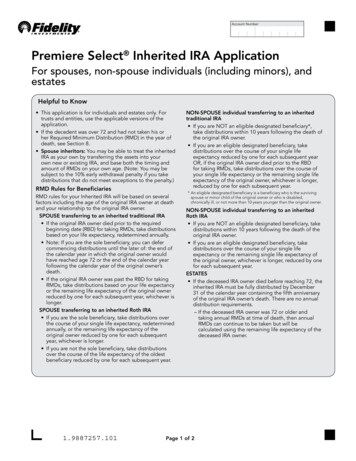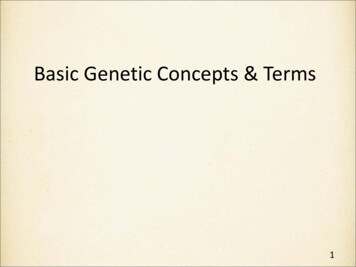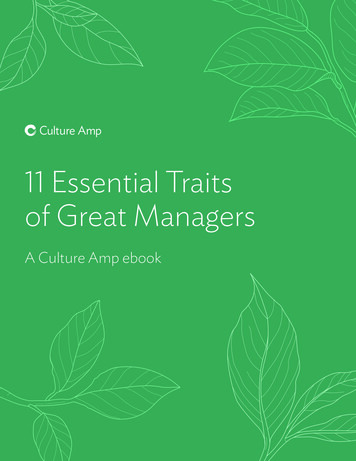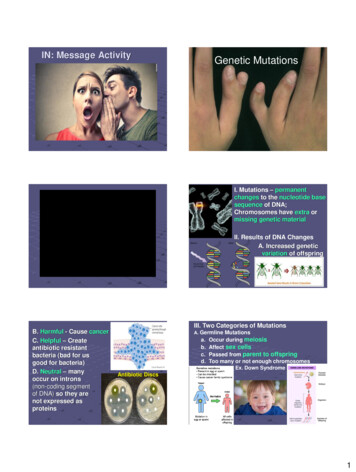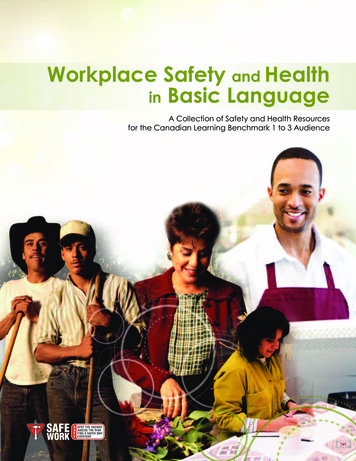
Transcription
Junior ScienceInheritance and VariationGeneticsClass Activity : Inherited Genetic TraitsHeredity is the passing of traits from parents to their offspring, either through asexual reproductionor sexual reproduction. The traits are passed on through genes. Different forms of the same trait arecalled Alleles. There are Dominant and Recessive alleles.Dominant alleles overshadow recessive alleles and thus can determine the physical expression of atrait.The term ‘genotype’ is used for the genetic makeup of an organism i.e. the pair of genes controllingthe characteristic. The ‘phenotype’ is the actual appearance of that trait.Homozygous genes are two of the same gene (GG or gg). Heterozygous genes are two differentgenes (Gg).ObjectiveIn this lab you will discover some basic concepts of human genetics.In this activity you are required to survey the members of your class for a variety of genetic trainst andto complete the class Traits Data Table below.Inherited traitsThe following are traits which are caused by a single gene.PTC TastingPhenylthiocarbamide (PTC) is a non toxic chemical that some individuals can taste. The ability to tastethis bitter chemical is inherited through a dominant gene. If you cannot taste or are a non taster, youcarry the recessive genes. Lets assign the letter T for the tasting trait and t for the recessive nontasting gene. If you can taste the PTC you carry the dominant gene T. If you cannot taste you haveinherited the homozygous recessive trait tt.Take a small piece of control paper. This paper is not treated with any of the PTC chemical. Chew itand mark any observations below. Then place the chewed paper in the bin marked biologicals/bodyfluids.Take a piece of paper treated with the PTC chemical. Chew it and mark any observations below. Thenplace the chewed paper in the bin marked biologicals/body fluids.What is your genotype for this trait?What is your phenotype?
Junior ScienceInheritance and VariationGeneticsBent Little FingerLay your hands flat on the table and relax them.Does the last joint of your little finger bends towardthe forth finger. If you have the bent pinkie finger youhave the dominant allele B. If the fingers are straightand extend parallel to each other out to the very tip,you carry the recessive allele b.What is your genotype for this trait?What is your phenotype?Pigmented IrisIf you are homozygous for the recessive allele p, you do not produce pigment in the front layer of youriris. If you have no pigment you have either blue or gray eyes. The P allele produces the pigmentwhich gives you eye colour. Eye colours are green, hazel, brown or black.What is your genotype for this trait?What is your phenotype?Attached EarlobesSome individuals have earlobes which are attached to the sideof their head and others have free or unattached earlobes .The unattached or free earlobe trait is dominant over theattached lobe trait.What is your genotype for this trait?What is your phenotype ?Tongue RollingThe ability to roll your tongue (see diagram below),is the result of a dominant gene. If you cannot rollyour tongue you carry the recessive trait.What is the tongue rolling genotype ?What is the non tongue rolling genotype ?What is your phenotype ?What is your genotype ?
Junior ScienceInheritance and VariationGeneticsHitchhikers ThumbSome individuals can bend the distal joint of thethumb back to nearly a 45o angle between thetwo joints of the thumb (see figure below).If you bend your thumb up or have distalhyperextensibility of the thumb you arehomozygous for this trait.What is your phenotype ?What is your genotype ?Hand Clasping or Interlacing FingersCasually fold your hands together so your fingersinterlace (see figure below). If when you clasp yourhands and you observe that your right thumb is overthe left you carry the dominant form of the trait R.What is your phenotype ?What is your genotype ?Widows PeakSome individuals have a hair line which dips to aslight V shape in the middle of their forehead.If you have a widows peak you inheritedthe dominant trait 'V'.What is your phenotype ?What is your genotype ?Mid Digital HairThe allele for hair on the middle segment of yourfingers is dominant to the allele for no mid digital hair.Look in the area between your nail and the mid joint,see if you have any hair in the mid digit area.If you have hair you have the dominant gene.What is your phenotype ?What is your genotype ?
Junior ScienceInheritance and VariationGeneticsData CollectionUse the chart below to collect the data that you generated by looking at your traits. Then collect thedata that your classmates observed. Use this table to generate class percentages for each trait.Class Traits Data TableDominant TraitNumber of PupilsRecessive TraitPTC TestNo to PTC TasteBent little fingerStraight little fingerPigmented IrisNon Pigmented IrisFree Ear lobesAttached ear lobesTongue RollNo Tongue RollHitch hiker ThumbStraight ThumbHand Clasp (Right)Hand Clasp (Left)Widow’s peakNo widow’s peakHair on fingersNo hair on fingersCurly HairStraight HairCleft ChinSmooth chinSmile dimplesNo Smile dimplesNumber of Pupils
Junior ScienceInheritance and VariationGeneticsCalculate the percentage of dominant vs. recessive traits for the class.Percentage of Dominant vs. Recessive TraitsTrait% Dominant% RecessivePTC TestBent little fingerPigmented IrisFree Ear lobesTongue RollHitch hiker ThumbHand Clasp (Right)Widow’s peakHair on fingersCurly HairCleft ChinSmile dimplesQuestions1.Which traits controlled by dominant alleles were shown by a majority of students in your class?Which traits controlled by recessive alleles were shown by a majority of students in your class?2.Compare your answers to questions 1 and 2. Are traits controlled by dominant alleles morecommon than traits controlled by recessive alleles?
Junior ScienceInheritance and VariationGeneticsClass Activity - Pipe Cleaner BabiesObjectives: In this activity you and your lab partner will play the role of parents.You will use chromosome and gene models to create four offspring and determinetheir genotypes and phenotypes.Then mathematically, you will determine the probability of having offspring withdifferent traits.ProcedureYou will receive a bag with pipe cleaners and beads. The pipe cleaners representchromosomes and the beads represent genes located on the chromosomes. In humans, thereare 23 pairs of chromosomes and thousands of genes, but for this exercise, we will only focuson a few.Without opening the bag, notice that you have four white and two coloured pipe cleaners. Ifyou have two pink chromosomes, you are to play the role of female (XX). If you have one pinkand one blue, you are to play the role of the male (XY).Questions:1. What do the pipe cleaners represent? .2. What do the beads represent? .3. Humans have . pairs of chromosomes.4. If you have two pink pipe cleaners, you are playing the role of the .5. The blue pipe cleaner represents the .chromosome.
Junior ScienceInheritance and VariationGeneticsThe Parents traitsRemove the chromosomes from the bag, but make sure you do NOT mix up you and yourpartner's chromosomes. Arrange the chromosomes in order of size, you should have twolong white pipe cleaners, two shorter pipe-cleaners, and the two coloured pipe-cleaners.The white pairs represent HOMOLOGOUS CHROMOSOMES.The coloured pairs represent the SEX CHROMOSOMESEye Colour (longer white pipe cleaners)Hair Colour (shorter white pipe cleaners)Dark Green bead represents the dominantgene - brown eyes (B)The red bead represents the dominant genedark hair (D)Blue bead represents the recessive gene blue eyes (b)The ivory bead represents the recessive gene- blonde hair (d)BB brown eyesDD dark hairBb brown eyesDd dark hairbb blue eyesdd blonde hairQuestionsWhat colour eyes does the mother have . What is her genotype? .What colour eyes does the dad have?.What is his genotype? .What colour hair does mom have ? .What is her genotype? .What colour hair does dad have? .What is his genotype? .Sex Linked Genetic Disorder - Annoying Laugh (X chromosomes)The orange bead represents the dominant gene ( normal)
Junior ScienceInheritance and VariationGeneticsThe red bead represents the recessive gene (Annoying Laugh)In girls:HH normalHh normal (carrier)hh annoying laughIn boys:H normalh annoying laughWhat is mom's genotype? . Is she a carrier? .What is dad's genotype? .Why doesn't dad get two alleles for this trait?.Time to Start Your Family The dad places one set of the homologous pairs (Eye colour) behind his back, with achromosome in each hand. The mom picks the hand she wants for the child. Lay thischromosome on the table in front of you and set the other aside.Repeat this procedure for the other homologous pair (Hair colour) and for the sexchromosomes. It should be noted that if the blue chromosome gets chosen from thesex chromosomes, the child in this cross is going to be a boy.Now the "mom" places one set of the homologous pairs behind her back and the malechooses.The chromosomes chosen and set on the table in front of you are the genes your firstchild received.Determine the Traits of Your First ChildArrange the chromosomes into homologous pairs and figure out what phenotypes(appearance or trait) the offspring has.QuestionsChildSex1234ObservationsEye ColourHair ColourAnnoyingLaughAnnoying LaughCarrier
Junior ScienceInheritance and VariationGenetics.Replace all Chromosome into the correct bag, make sure you have the rightchromosomes in the bag and return.
Junior Science Inheritance and Variation Genetics Class Activity : Inherited Genetic Traits Heredity is the passing of traits from parent
